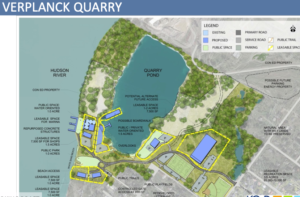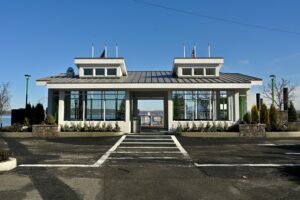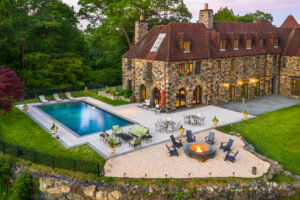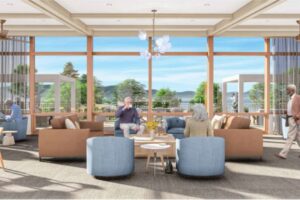
The Town of Cortlandt took one step closer towards its realization of a commercial and recreational development around the Verplanck Quarry when it heard proposals from a team of architects at a recent meeting.
The 99-acre parcel of land, which includes the flooded 31-acre quarry, was acquired by the town from Con Edison in 2016. Four years later, the imminent closure of Indian Point, and the resulting loss of jobs and tax revenue, prompted the federal government to award Cortlandt a $3.2 million grant, which was used to kickstart the quarry development.
As it did in response to the Indian Point closure, the Town formed a committee, comprising local officials and residents, to discuss plans for the future. One of the committee’s first tasks was to evaluate proposals from three potential tenants – an indoor athletic field known as Cortlandt Pitch, Merchant’s Daughter hard cider mill, and Brownstone outdoor adventure park.
***
The Brownstone facility, which would have been located on the western shore of the quarry and offered experiences such as zip lining and cliff climbing, was not approved. Town Supervisor and committee chair Richard Becker agreed with the decision.
“It was too directed at being commercial, and attracting people from outside the area,” said Becker. He feels that, for many, it would be a one-time destination and not something people would revisit.
The committee is leaning towards creating a municipal recreation area in the same spot, which guests could use at low or no cost, similar to Charles Cook Pool.

According to KG&D Architects, which presented a preliminary plan to the committee, there are between four to six plots of land on the property that could be leased to commercial tenants. The goal is to create a hybrid of private, leased spaces plus public spaces.
“It really should feel like a park, with clearly defined separate uses, not a city street,” said KG&D President Russell Davidson.
Part of the plan presented by KG&D includes a three-acre park in the southwest corner of the property, with access to nearby White Beach. The beach itself could potentially be home to a marina or water taxi service.
***
Local resident Michelle Piccolo-Hill spoke about the possibility of preserving and repurposing several partially submerged buildings along the quarry’s west coast, as well as a group of concrete silos adjacent to the potential Merchant’s Daughter location.
“You just can’t get that stuff back,” said Piccolo-Hill. “There are too many beautiful old places that are destroyed with the immediate thought of ‘Let’s do this quickly and cheaply’.”
Becker agreed, and pointed out that the nearby KinoSaito arts center, whose President Mikiko Ino also serves on the quarry committee, has proposed incorporating the silos into a sculpture garden.
KG&D’s Davidson said that while converting partially submerged buildings into usable commercial space has many challenges, they could be used to create docks for the recreational area.
***
The plan is not without some detractors. Committee member Christopher Vargo has been vocal in his disapproval of the quarry plans, which includes concerns about infrastructure and traffic. He claims that any tax revenue or lease payments to the Town would be nullified by the expense of maintenance.
“The whole idea is a lose/lose for the residents of Verplanck,” says Vargo. “If it’s popular, the traffic will be terrible, and if it’s a failure, we are stuck with empty buildings that the town will have to maintain.”
The next step for the committee is to hear from a team of structural engineering consultants to begin addressing infrastructure issues, lighting, water mains, septic systems that need septic tank pumping, and irrigation lines that don’t have enough pressure to distribute water.
Becker reminded participants throughout the meeting that nothing is set in stone, and that the process is a flexible one. Each component of the development must go through the usual planning board process, and will operate on its own timeline.
“This isn’t Disneyland,” said Becker. “It doesn’t have to open all at once.”
Christian Larson, who lives in Peekskill, is Editor-at-Large of River Journal North, and host of its podcast RiverTalk. He is also an event planner. Visit him > capngoodtimes.com.







More comments and input is needed regarding EMS and Fie Protection . High risk area.
Agree with Becker wish he responded to my email 2 months ago. Linda Puglisi was always timely in response.